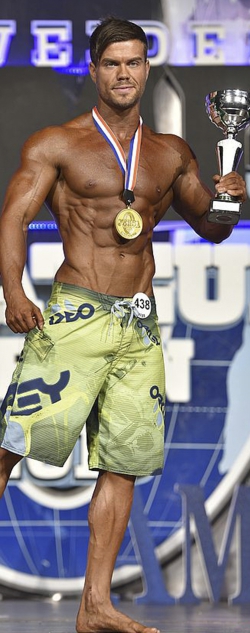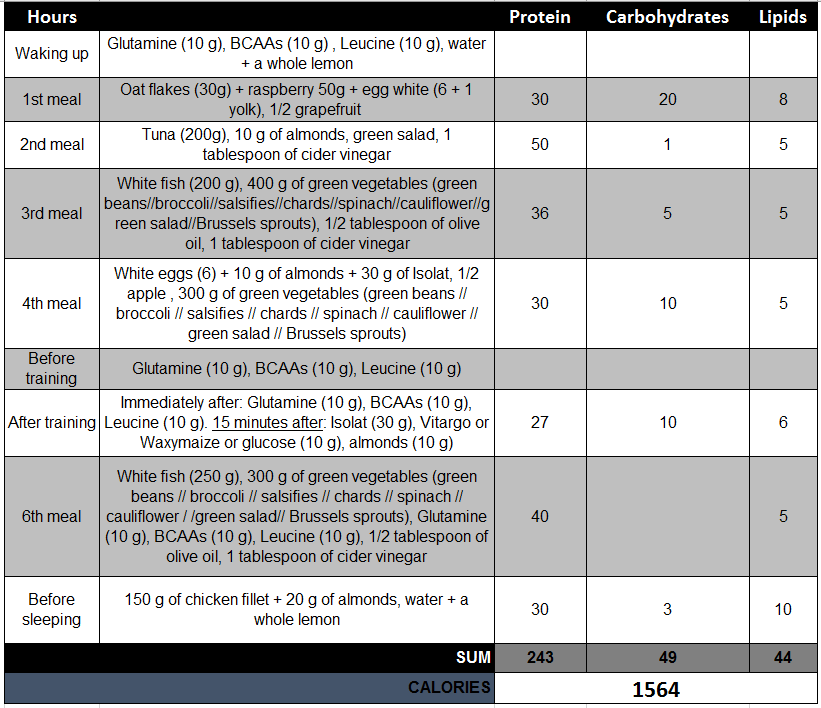
Preparing for a competition: From A to Z. Part 4

We continue our study on the preparation for a sports competition, the study that gives you the basic knowledge you need in order to make this difficult initiative successful.
Now we have to address some concrete aspects in order to provide you all the practical information necessary to prepare for a competition. We are going to talk about the concrete training, the concrete diet, and we will also include a chapter on supplements – so you will have all the keys of your successful arrival on the stage in your hand, without any possible excuses. Then we will talk about the specific pre-competition periods: the discharge period and the adequate amount of supplements to be used from the range of BioTechUSA, the recharge period and the adequate amount of supplements, the water management during the pre-competition phase and the adequate amount of supplements, the nutrition on the day of the competition, and finally advices and recommendations for the post-competition break period.
Being the most complete, with the best lines and best definition possible according to the criteria of the category, is the objective of every sportsman who gets on stage. If this is your first competition, you have tons of questions and things to review with a trainer, who will help you to eliminate your fears and to achieve your goals.
So, what do I have to do to start losing adipose tissues?
General principles
Weight yourself before breakfast, because this will show you your real weight. As you can imagine, if you weight yourself later during the day, you will be heavier because of the meals and fluids you have consumed.
One thing to keep in mind – in order to fasten the weight loss, many people reduce the amount of carbohydrates and increase cardio without limits, which is a stupid thing to do: the objective is to be shredded on stage, it’s true, but you also need to be muscular. But how can we expect to keep the muscles, if the food intake is more than reduced, and the cardio is more than increased? Cardio – a session of 30 minutes in the morning before breakfast, and one of the same length after training – is enough to eliminate the adipose tissues without losing any muscles, what happens necessarily if you exaggerate the duration.
Let’s summarize the steps:
 A. Step 1
A. Step 1
Start your diet with proper and healthy foods. If your nutrition is a little unhealthy, start by replacing it with quality foods, do this approximately 4 weeks before you start the true preparation for the competition (if you do a 12-weeks diet, start the cleaning phase 16 weeks before, so your nutrition will be perfectly healthy 12 weeks before).
B. Step 2
Do cardio for 20-30 minutes, one time every day, after training, starting 16 weeks before, especially if you don’t do off-season habits – you will lose body fat quickly.
C. Step 3
Whet the weight loss becomes slower, the next step is to do more cardio on days without training.
D. Step 4
Then, when things become slower again, increase your cardio by 10-15 minutes per session.
E. Step 5
The next step is the one you can expect – keep the cardio session before breakfast on days without training, add an extra session at night, and do a session before breakfast, and an other after training on active days.
F. Step 6
When the weight loss becomes slower again, reduce your carbohydrate intake by 50-200 grams on days without training (the amount depends on your diet and the weight category in which you want to compete).
G. Step 7
If you need to, you can reduce your carbohydrate amount by 100 grams per day, even to 30-50 grams in extreme cases, because – as we already said – there is no need to increase the duration of cardio sessions. Lipids will not exceed the amount of 0.5 g per each kilogram of your body weight then. You have to keep protein on a high level, at 2-3 grams per kilogram.
Your goal should be: reach your competition shape 1-2 weeks before the show. This will allow you to eat much better before the competition, regain some muscle, rest and refine things as they have to be, while knowing that the hardest part of the work has been done.
Diet
You can also check our articles on the site of BioTechUSA dedicated to the nutrition of shredding, with calculations of nutrition intakes (protein, carbohydrates, lipids) during the pre-training period – the intakes are calculated according to the body weight, the intensity of the training, and (above all) the calorie deficit necessary to reach the constant loss of adipose tissues, well-measured and controlled.
There are many different diets, they all have the same role: to increase the metabolism of the body to the maximum while reducing the entries, in order to cheat the body and force it to consume the maximal amount of calories, while providing an increase in calories well below the level of use. Low-calorie diets, cyclic diets, ketogenic diets and so on… an entire book would be necessary to list them, so we will give you a simple and precise example of a diet that is possible to adopt. Don’t forget the rule – if a diet has a proper name (generally named after the person who “invented” it), it’s usually not (very) effective.
This is a sample diet for a person who weighs 80 kilograms, with a low level of carbohydrates and lipids (last phase).

Supplementation
Observe that each training – regardless the used techniques – is a pure and simple destruction of the muscle tissues, so that the body repairs them and builds more to avoid future stress, it’s necessary to understand that the tissue is only repaired – and therefore grown – during the period of rest and diet, and not during the time you exercise in the gym. The supplementation has a very important role, especially in the context of preparing for a competition, where the mechanic physical work is very intensive and varied, and nutrition intakes and resting periods are both reduced. The food supplements help to recover, to maintain performance, to grow lean tissues, and to recover mentally and psychologically.
You can check our special sports supplementation file “Sports supplements: a brief guide for the beginning”, but in the nutrition plan presented above, you can also see the importance of BCAA amino acids, Leucine, Glutamine (morning, before and after training, and before sleeping), the post-training Isolat with Vitargo, but also the importance of multivitamins and minerals. It’s possible to add joint protectors to this intensive phase, but you can also add complete amino acids in order to preserve the correct intakes during this restrictive phase.
Over the course of our long study, we will address the trainings with a very specific example, and also some very specific phase of the preparation, such as carbohydrate depletion, recharge, water management and the day of the competition.